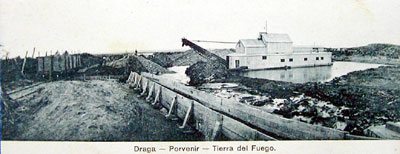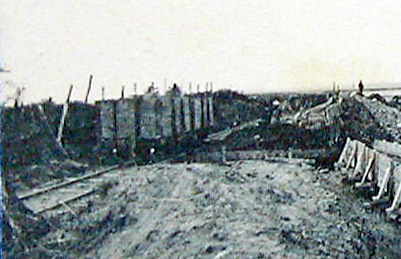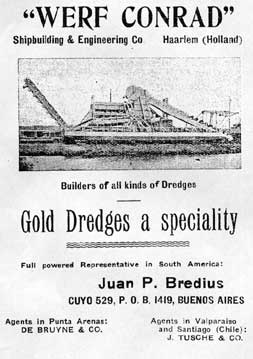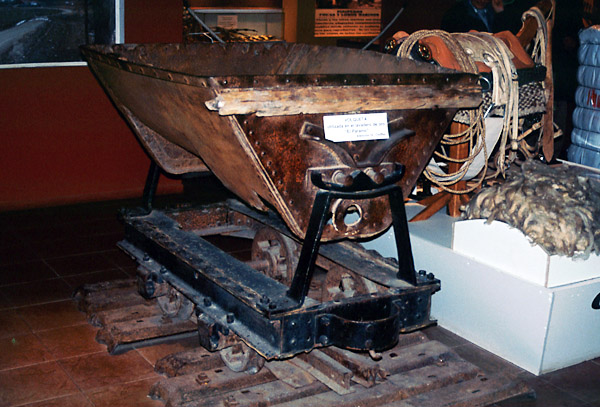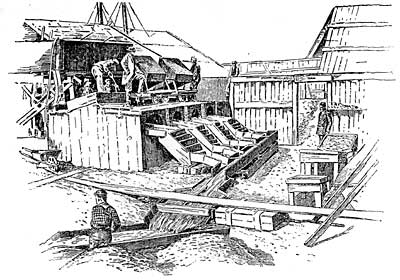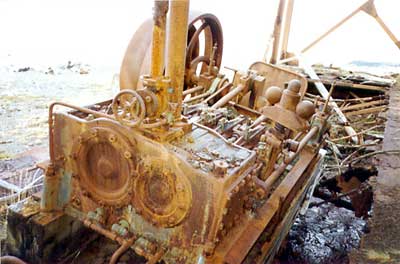 |
||||||||||||||
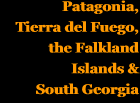 |
||||||||||||||
 |
||||||||||||||
 |
||||||||||||||
Gold dredging There were major gold workings around Porvenir in the Chilean part of Isla Grande but also lesser known and shorter-lived workings further east and south, such as at Russfin south of Cameron. Argentine sites included Bahia San Sebastian north of Rio Grande, and Bahia Sloggett near Cape San Pio east of Ushuaia. Alluvial gold First, if the gravels are well above the water table, it was common practice in the past to sink a shallow shaft and then mine by hand outwards from the bottom. Shallower deposits would merely be shovelled up. Nowadays, of course, mechanical excavation would be used. The material was then run through a preliminary course screen (a 'grizzly' in California and Yukon terms) to get rid of large stones. The real sorting was then done in a series of water filled troughs, in which any particles of gold would separate owing to their high specific gravity, collecting in a series of riffles (parallel ridges and hollows within the trough bottom) or even in a blanket material with which the troughs were lined. As an area was systematically worked, the troughs would be moved to the gravel. It was therefore unusual for a railway to be needed in the actual working of an area. On the other hand, if the alluvium was waterlogged, a different method was needed. In this case all the necessary equipment - a bucket line, a rotating separating drum or trommel, screens, water-filled troughs, and a discharge conveyor belt - would be mounted in an iron hull together with the necessary boiler and steam donkey engines. The equipment moved systematically across the beds of gravel, floating within a constantly changing area of water. Again, railways were not needed for the actually working of an area, but they might have been necessary for the initial import of the dredger parts. A number of dredgers were imported into Tierra del Fuego during a short-lived gold rush in the early 1900s. Smaller scale operations had begun as early as the 1880s and indeed still take place near Porvenir. Porvenir However, an old postcard, forwarded by Señor David Guevara, clearly shows a railway being operated in connection with one dredger. This has been linked with the 1904-9 Mina Nueva operations of the Sociedad Anónima Lavaderos de Oro de Tierra del Fuego. This company ordered three steam gold dredges from the Dutch company, Werf Conrad. The dredge, or 'draga' in Spanish, is the boxed-in building-like contraption on the right. Dredgers of this kind were large machines. They contained a boiler and a number of small donkey engines to drive the various machinery. In the centre of the photo is a sluice built up of wooden boards. In this case it would be bringing water to the pond in which the dredger is floating, rather than being used to sort the alluvial material itself. On the left is a single railway line with two wagons. A number of men are working near the wagons.
Below is an enlargement of part of the postcard above. The wagons can be seen to be high-sided planked four wheelers, sitting on what might be metre gauge track. Wagons of this size coupled together would almost certainly have required steam power to move them.
The ad. on the left shows a gold dredger complete apart from its outer shell at the Werf Conrad shipyard at Haarlem in the Netherlands. The dredge pictured above might well have looked like this without its cover. On completion such a dredge would have been dismantled and crated up for delivery to its user. The advert appeared in the English language newspaper The Review of the River Plate in 1906.
El Páramo - Bahía San Sabastían During the 1880s a Romanian explorer and engineer, Julio Popper, set up the El Paramo company to extract gold from alluvial deposits in Tierra del Fuego. David Guevara's website (2) has much detail about the operations (in Spanish only, but with photos) and in a quote from that period is mentioned 'a line of Decauville track' at Bahia San Sebastian. Later on, in 1922, the nearby Estancia Cullen laid 3km. of track along the peninsula to aid in the export of their wool. This railway, which is covered in Chapter 8, may well have used rails and wagons dating from the earlier gold workings.
The photo above, taken in Rio Grande town museum, shows a skip brought from the El Paramo site. Whilst it could be from the later estancia line, they are unlikely to have needed new skips for carrying wool (!) and the chassis looks fairly old, without the pressed curved ends more commonly seen. The drawing below shows a couple of skip wagons being tipped at the El Paramo gold washing plant .(3).
Bahía Sloggett
The photo above shows the huge size of the gold dredger still lying at Bahía Sloggett, whilst the one below illustrates one of the Ransome Sims & Jeffries steam donkey engines which drove the various parts of the machine. In the picture above there is a doorway in the lower centre to give the scale.
References: 28-5-08 |
||||||||||||||
Chapter 13
A variety of industrial railways


